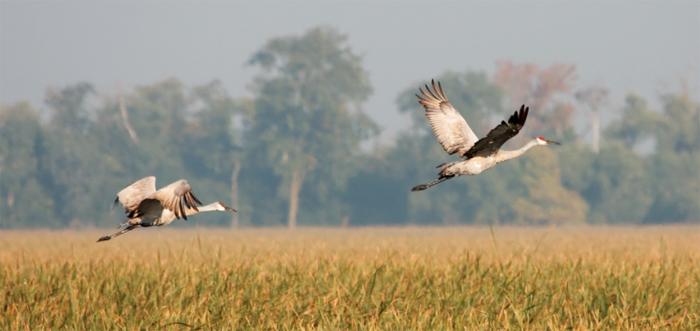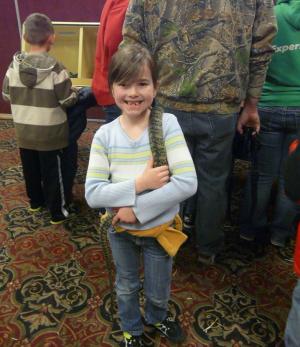

During four to six weeks from the beginning of March and into mid-April, nearly half a million Sandhill Cranes, roughly 80% of the world population, arrive in south-central Nebraska. The birds descend on a 75-mile-long stretch of the Platte River, the Central Flyway for the Sandhill Crane migration. This area along the Platte is full of safe aquatic roosting habitat, food resources and agricultural fields essential for feeding. Here, the birds rest and rejuvenate during their journey from parts of Texas, Mexico, New Mexico, Arizona, and California and then fly northbound to their nesting ground located in Michigan, Minnesota, Wisconsin, Idaho, as well as parts of Alaska. The Platte River is a stopping-off ground for the cranes, where they forage on sprouts, seeds, insects, fish, and frogs, as well as small snakes and rodents. Along the Platte, the crane migration becomes a narrow, funnel-shaped flyway zone densely populated with nearly 500,000 birds stopping to feed along these plentiful areas. Sandhill Cranes have captivated people of all ages, who become fascinated by their elegance and grace. Now, however, the cranes are facing threats from a changing climate and increased habitat destruction.
Spreading knowledge about creatures whose migration patterns fall into rural, isolated areas can be a challenging task. How can we help these birds? Each year the Nebraska Audubon society hosts the Audubon’s Nebraska Crane Festival where hundreds of local community members as well as nature enthusiasts from across the United States come to learn more about Sandhill Cranes and how they can help preserve this invaluable species. Many of the young people who attend the festival come to learn more about how to help protect this species.

Nicky Faraco-Hadlock, a 13-year old from Conifer, Colorado, attended the Audubon Nebraska Crane Festival with his family because of his love for all things wild. He first became interested in birds around age seven. He hopes to continue to learn more about bird behavior and one day become an ornithologist. Nicky believes it is crucial to stress how young people working with others in the community can help the cranes.
Another young leader, Monica Keep, of Nebraska Game and Parks Commission, currently works as a Wildlife Education Assistant where she leads and educates the community on the importance of conserving the natural world. Monica expressed how “everyone has a responsibility to help protect our environment, even if you are detached from nature in your day-to-day life.”
The KidZone-Kearney Area Children’s Museum has also worked towards engaging youth in environmental initiatives and hands-on activities. As Director of Programs and Community Engagement at the Museum, Jennifer Beck seeks to engage the public with interactive, educational experiences where children can learn through exploration. In the Science Zone, children can learn more about nature and the environment and can meet two Sandhill Cranes, Andy and Sandy. In addition, museum visitors can learn facts about the Sandhill Cranes, including how females lay their eggs, the lifespan of the birds, and about their unique “dancing” ritual where the cranes bow, run, jump, and flap their wings in a ceremonious manner.
Many Audubon’s Nebraska Crane Festival attendees attend crane observation groups viewing the birds from blinds at Rowe Sanctuary, a 1150-acre refuge along the Platte River. Rowe offers tours during the migration time as well as education programs in nature and conservation practices that specialize in the Sandhill Cranes. Those who are unable to attend the festival events may view the cranes during their migration along the Platte on the live Crane Cam also located in Rowe Sanctuary.
At the Nebraska Crane Festival, Brian “Fox” Ellis, an author and professional storyteller, explained the importance of storytelling as a tool for interpretation, education, and environmental outreach. Sharing stories about the lives of the cranes offers more than simple, factual knowledge, he believes. Storytelling appeals to our human emotions, awakening people to their relationship with the natural world, and making them care at a visceral level about the birds.
But what is the future of these magnificent birds? The Audubon Birds and Climate Change Project points to climate affecting migration patterns of Sandhill Crane populations. In addition, habitat destruction is an issue. The wet meadow habitats are crucial for the birds, but these low-lying areas are disappearing due to human pressure, putting stress on crane resting areas along the Platte. Furthermore, the birds play a crucial role in ecosystem pest control by feeding on insects and rodents that can damage crops throughout these areas, so the loss of Sandhill Crane habitat of the Platte will negatively affect crops in the area.
Additional Resources Regarding Sandhill Cranes
Priority Information Needs for Sandhill Cranes Funding Strategy
Thumbnail photo by Gary Zahm under public domain license courtesy U.S. Fish and Game Service. Lead photo by Dori under Creative Commons Attribution-Share Alike 3.0 Unported license. Second photo used with the permission of Emily Baumbach and may not be reproduced.